Explore the most effective types of email marketing campaigns and learn how to leverage different emails to engage your audience.
December 4, 2023
7 Types of Email Marketing Campaigns for Effective Engagement
Question
I’ve only recently started in email marketing.
Which email campaigns are the best for engaging customers?
Answer
Email campaigns fulfill diverse marketing goals: re-engaging a lapsed customer might involve a personalized email with a special promo code, while encouraging additional purchases from active customers could be achieved by suggesting items related to their past shopping behavior. There is no one-size-fits-all campaign.
Let’s outline different types of campaigns that you can use in your email marketing strategy.
Newsletter Emails
The primary goal of newsletter emails is to remind your audience about your company and enhance subscriber loyalty. The content of these newsletters can vary widely, but the key is to ensure it’s useful and engaging for the client. This could include a range of materials such as news updates, articles, video tutorials, or digests — brief summaries of content with links to full versions.
When to Send Newsletter Emails
Consistency is key when sending these types of mail campaigns. Regular scheduling trains users to expect your communications on specific days, creating a routine touchpoint with your audience. A well-planned content calendar covering different types of email campaigns can guide this process. For example, you might send a digest of current promotions on Mondays, a news digest on Tuesdays, take a break on Wednesdays and Thursdays to avoid overwhelming your audience, and then send newsletter emails on Fridays.
To avoid bombarding customers with multiple, potentially irrelevant newsletters, sports store Decathlon segments its audience based on interests and purchase history to send newsletter campaigns tailored to each segment. This results in relevant and useful content for all recipients — for instance:
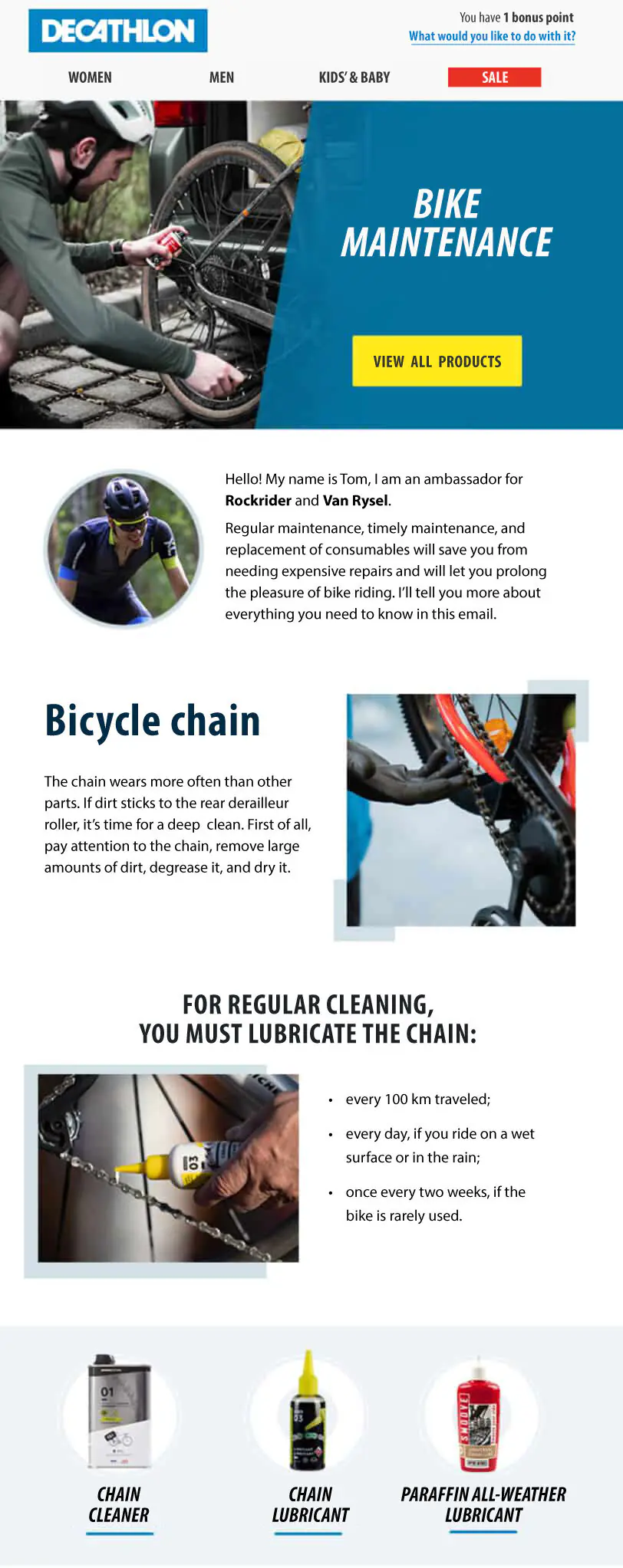
After purchasing a bike from Decathlon, customers receive informative newsletter emails on bike maintenance
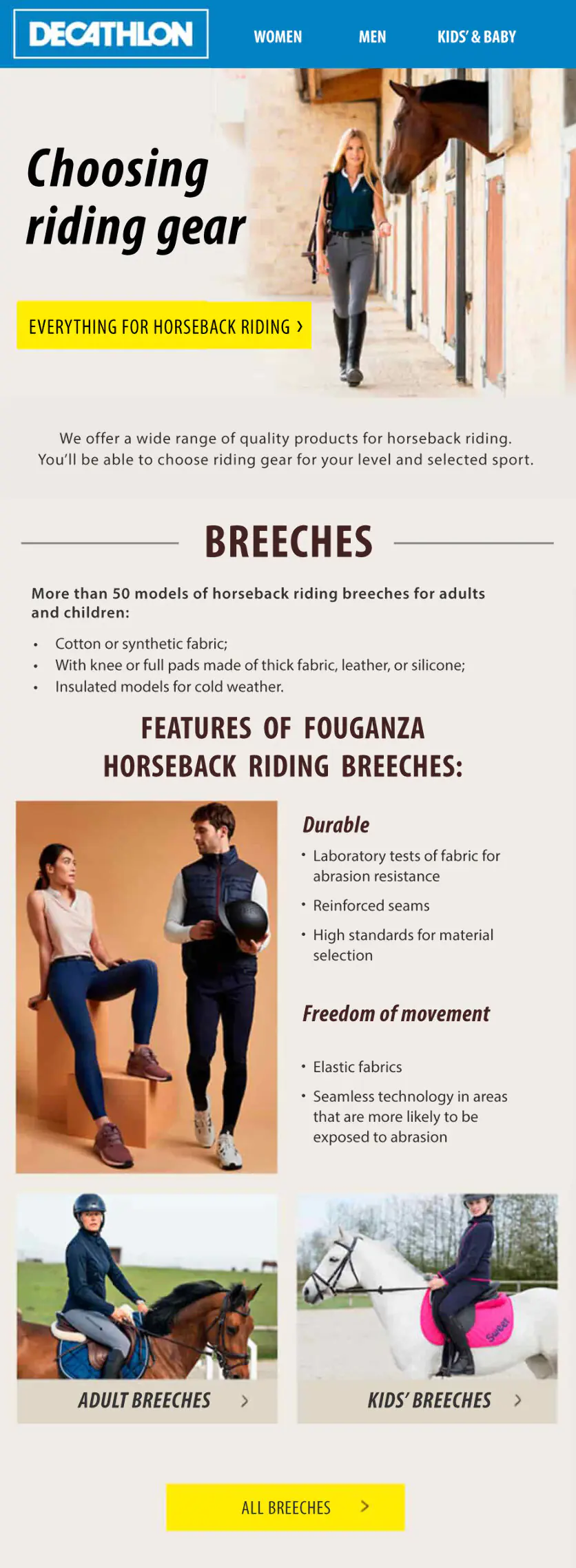
Customers that have expressed interest in horseback riding are sent a regular newsletter tailored to this interest — the same approach is used for other sports
Promotional, Discount, and Special Offer Campaigns
The primary objective of promotional emails is to drive sales by leveraging time-sensitive opportunities. These campaigns are often designed around specific events or limited-time offers, such as Black Friday discounts, new collection releases, or seasonal sales. The best practice for these types of emails contain a promotional banner to capture attention, succinct and engaging text, and a compelling call to action to prompt immediate response.
Video software company, Movavi, sends out promotional emails at multiple occasions throughout the the year, which includes seasonal campaigns such as Spring, Summer, and Valentine’s Day sales:
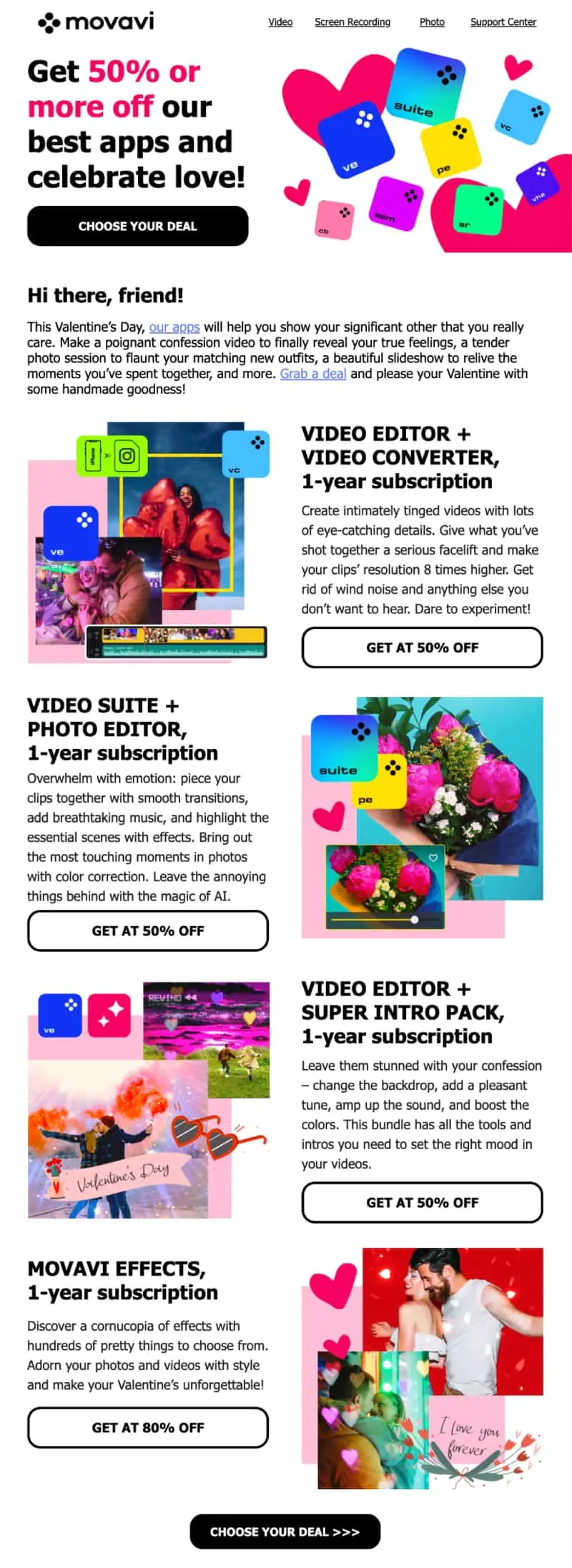
A Valentine’s Day campaign for Movavi’s subscribers
When to Send Promotional Campaigns
For campaigns tied to specific sales events, the timing of the email is key. It’s effective to send out a preliminary email a few days before the event, allowing customers to plan their purchases. For example, a reminder early in the week for a Black Friday event, followed by a last-minute prompt on the day, can significantly boost engagement and sales. For campaigns tied to specific sales events, the timing of the email is key. It’s effective to send out a preliminary email a few days before the event, allowing customers to plan their purchases. For example, a reminder early in the week for a Black Friday event, followed by a last-minute prompt on the day, can significantly boost engagement and sales.
Regular promotional emails, like monthly discounts, need to be balanced carefully. Overdoing these types of mails can dilute your brand’s value and lead to a discount-driven customer base. The frequency of these emails should be tailored to match the buying habits of your customers, ensuring that each promotion feels special and valuable. For example, you could send out monthly promo codes to most of your customer base, excluding frequent buyers who are likely to purchase without this incentive.
Reactivation Emails
Reactivation campaigns are strategically designed to re-engage subscribers who have become inactive over time. These types ofemails serve a dual purpose: they attempt to rekindle a relationship with lapsed customers and help streamline the marketing database by identifying and removing unresponsive contacts.
Instead of a single email, effective reactivation typically involves a sequence of messages. This multi-step approach is crucial as it allows for a nuanced re-engagement strategy, helping avoid unnecessary discounts for customers who might only need a gentle reminder about the brand’s offerings. The sequence can include a mix of emails: showcasing best-selling products, offering promotional codes, sending reminders about current offers, and even delivering content that adds value to the customer’s experience. Tools like mind map software can be invaluable in mapping out and visualizing these email sequences.
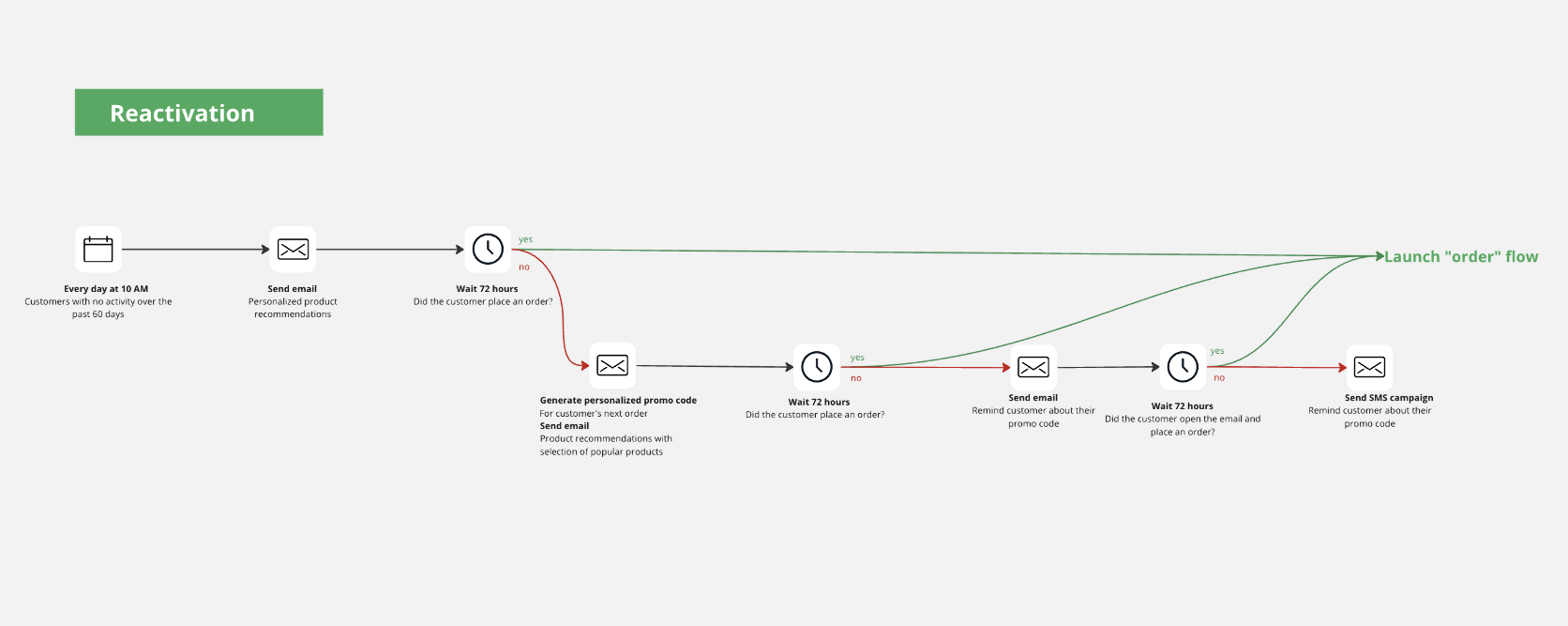
An example of what a basic reactivation email sequence may look like — this visualization was designed using Miro, an online mind mapping tool
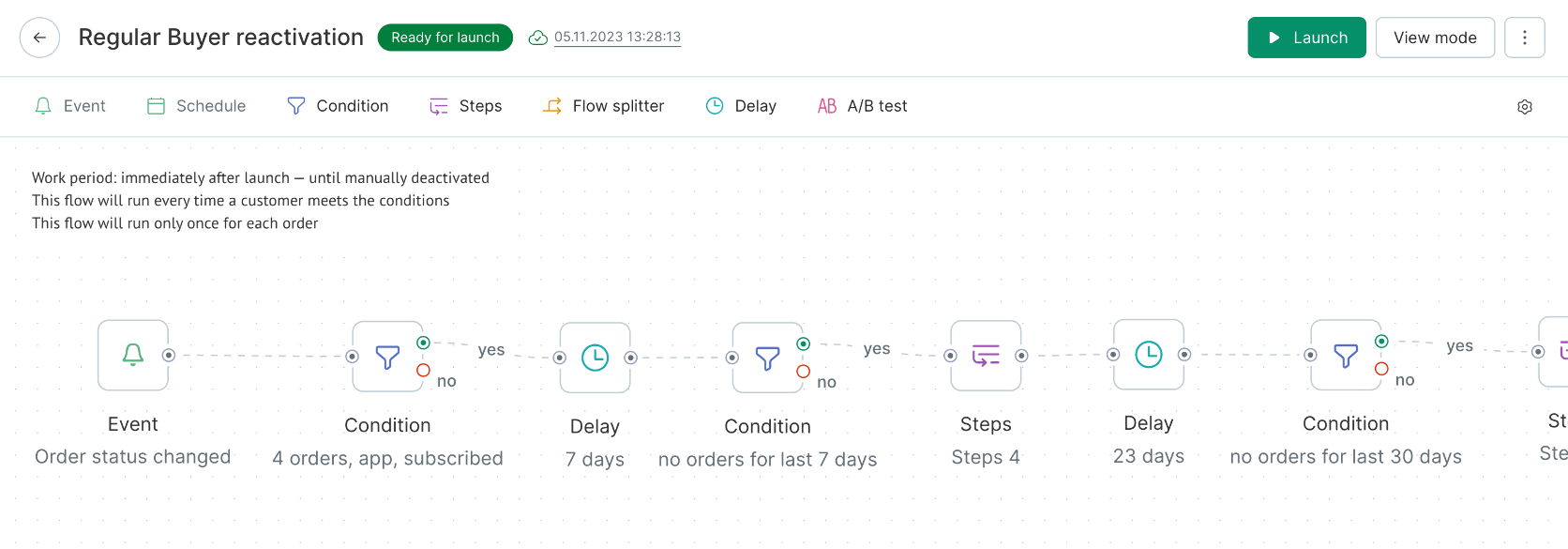
An excerpt of a more complex reactivation series from Pinemelon
When to Send Reactivation Campaigns
The ideal time to send reactivation emails varies based on customer behavior and engagement patterns. They are particularly useful for customers whose interaction with the brand has diminished — such as those not visiting the website, making purchases, or engaging with previous emails. Reactivation campaigns can also target new customers who have joined the email list but haven’t made any purchases yet. Encouraging them with a first-time buyer discount or a curated selection of popular items can be effective.
Typically, these types of emails are scheduled to be sent at intervals — 30, 60, or 90 days after the last engagement or transaction. However, these intervals should be customized based on the specific purchasing cycles of your customer base. For regular customers, a reactivation email might be more appropriate if there’s been an unusually long pause since their last purchase. For newcomers, a reactivation message could be sent just a few days post-registration to prompt their first purchase.
For instance, Blossom Flower Delivery uses a two-step reactivation campaign with a promo code and reminder to motivate customers to visit the website and make a purchase:
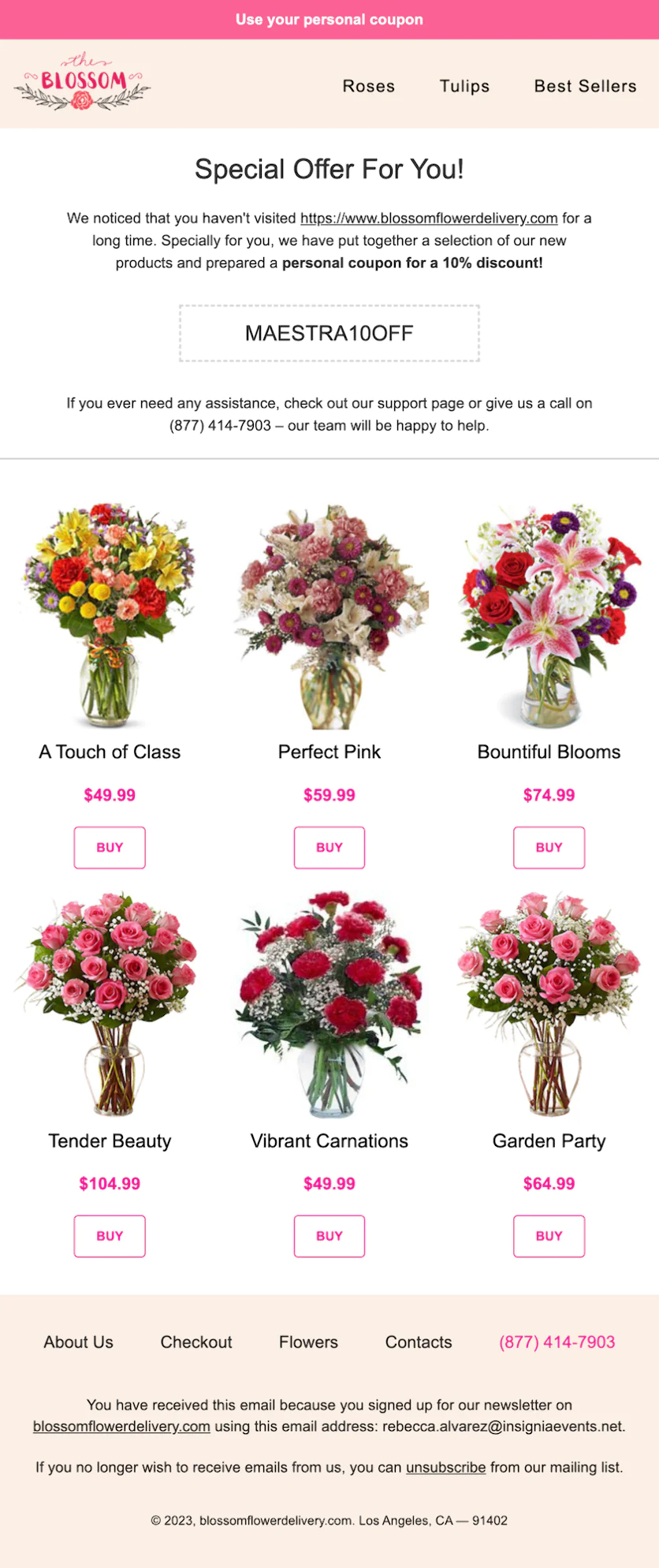
The first email presents customers with a promo code and a selection of new bouquets
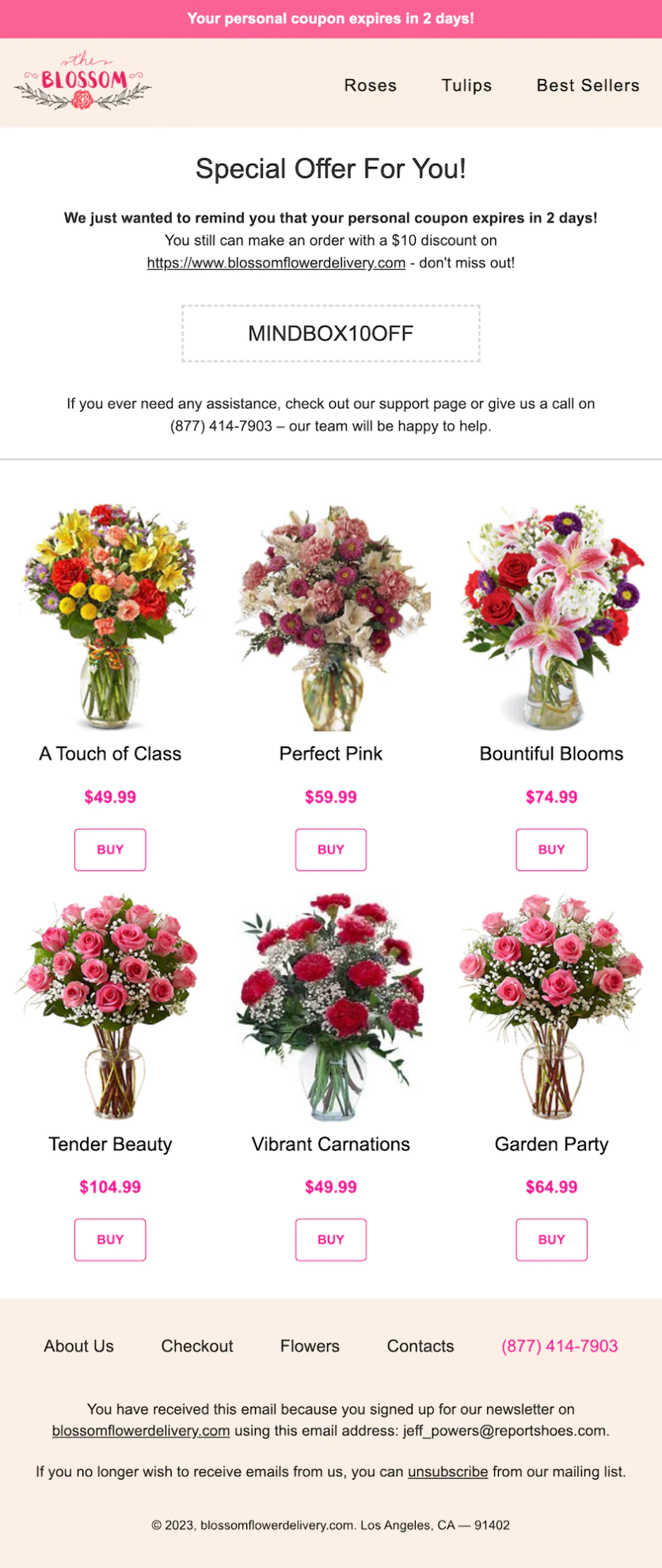
The second email is sent 5 days later, reminding customers that their promo code expires in 2 days
Welcome Emails
Welcome emails are the first step in building a strong relationship with your new subscribers. These types of emails are often not singular messages but part of a series designed to gradually introduce new and potential customers to the brand. This approach ensures a comprehensive and engaging introduction, setting the stage for a deep and lasting connection.
This first touchpoint is an opportunity to make a positive and lasting impression. It’s essential to personalize the welcome message, perhaps by using the subscriber’s name or referencing their specific interests. Including a special offer or a unique discount for new subscribers can also be a powerful incentive, encouraging them to make their first purchase.
In addition to offers, welcome emails can provide helpful information, such as links to popular products, FAQs, app download links, or tutorials about using your services or products. This informative approach helps new subscribers feel supported and valued, fostering a sense of connection right from the start.
When to Send Welcome Campaigns
The first welcome email should be sent immediately after subscription, capitalizing on the initial interest and engagement of the new subscriber. This prompt response helps cement the relationship and increases the likelihood of conversion from subscriber to active customer. Quick and consistent follow-up emails keep the momentum going, enhancing the opportunity for engagement and conversion. At the same time, it’s important to give customers 1-2 days between emails to ensure they do not feel bombarded with communications. Ultimately, each brand’s audience is different, so you may need to test different approaches to determine what yours responds best to.
Health food store Pinemelon, for example, has developed a “Welcome” communication flow with multiple branches, where email content varies based on whether the customer has made their first purchase and subsequent purchases after that.

The first Welcome email provides new customers a $15 discount on their first order, highlights the brand’s local-first approach, and offers a selection of product recommendations

Customers who did not place an order are sent another email with a promo code for 20% off, along with product recommendations and more info on the benefits of shopping with Pinemelon
Transactional Emails
These types of emails are crucial in providing timely responses to customer interactions. Transactional emails encompass a range of notifications, such as confirming payments or alerting customers when an order has been dispatched or is ready for pickup. They stand out due to their directness, automation, and personalized nature, ensuring customers are informed about the status and progression of their interactions with your business.
Given their informative nature, transactional emails are usually free from promotional content. Their primary aim is to update customers, as opposed to serving as a marketing tool. This means they are also sent to customers who have opted out of marketing emails. If you decide to integrate marketing content into transactional emails, careful consideration is necessary to avoid reaching those who have unsubscribed from promotional messages.
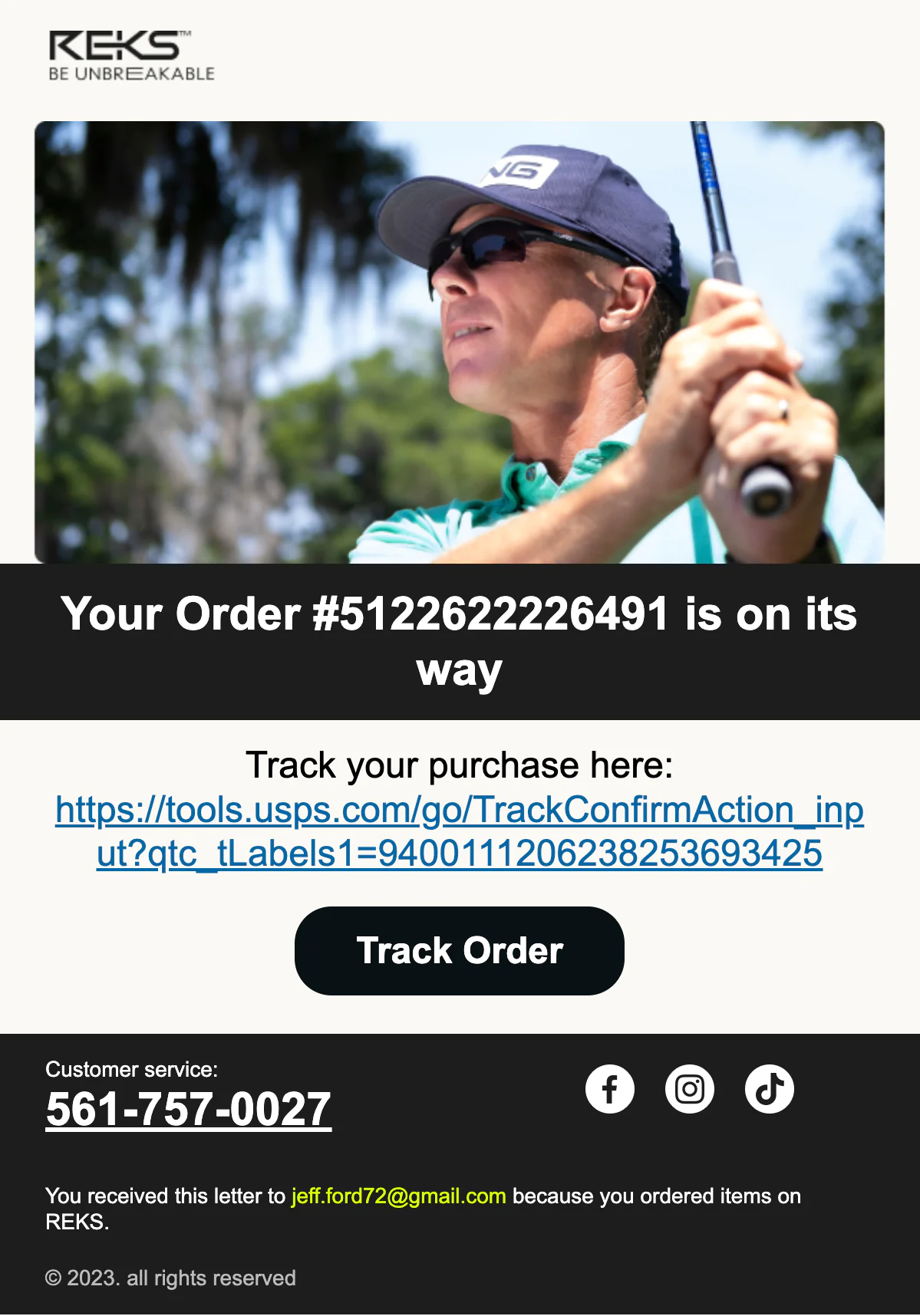
An example of an order update email from optic shop REKS
When to Send Transactional Campaigns
The key to transactional emails is their immediacy. These types of emails should be set to dispatch automatically and instantly, regardless of the time. This responsiveness is vital as customers expect these updates without delay. For instance, a customer making a restaurant reservation online anticipates an immediate confirmation to finalize their plans — a delayed response risks a change in their plans, highlighting the necessity of prompt and accurate transactional emails for customer satisfaction and retention. Similarly, customers placing an online order tend to expect a confirmation email relatively soon after their purchase.
Milestone Emails
Milestone emails celebrate significant events in the customer’s journey or relationship with your brand. These types of email campaigns are an excellent way to foster personal connections and show your customers that you value and recognize their loyalty. Milestones can include anniversaries of a customer’s first purchase, their birthday, or even the anniversary of them subscribing to your newsletter.
When to Send Milestone Emails
The timing of milestone emails is inherently linked to the individual customer’s journey with your brand. It’s crucial to have an automated system in place to track these milestones and send out personalized emails on these special occasions. For instance, a birthday email with a personalized discount code or a special offer on the anniversary of their first purchase can make a customer feel valued and strengthen their bond with your brand.
Blossom Flower Delivery uses various milestone campaigns to remind customers to place an order for a birthday or anniversary gift. These emails are sent a few days before the occasion to ensure customers have enough time to place their order:
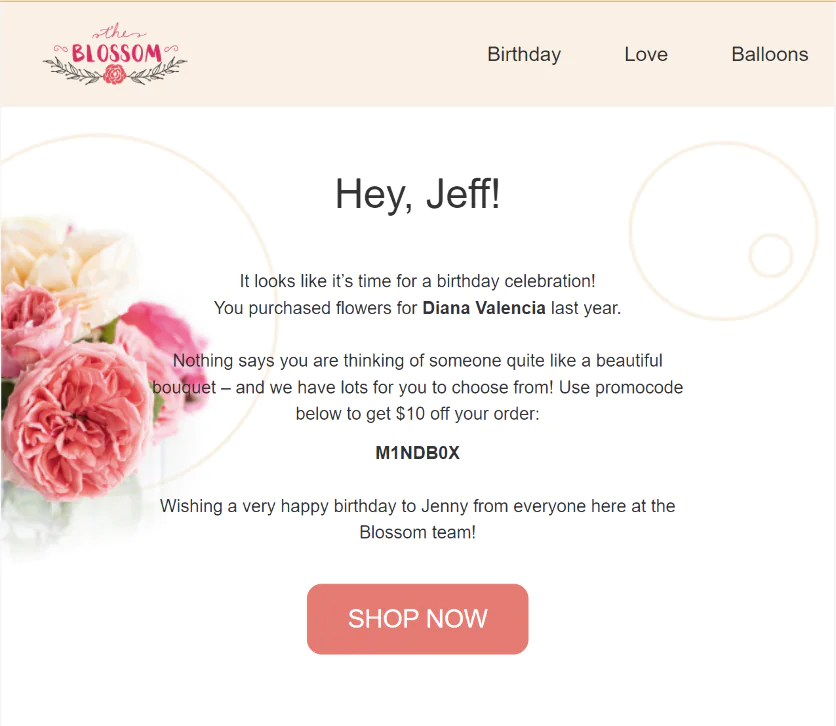
An example of a campaign sent to customers who purchased a birthday bouquet a year ago
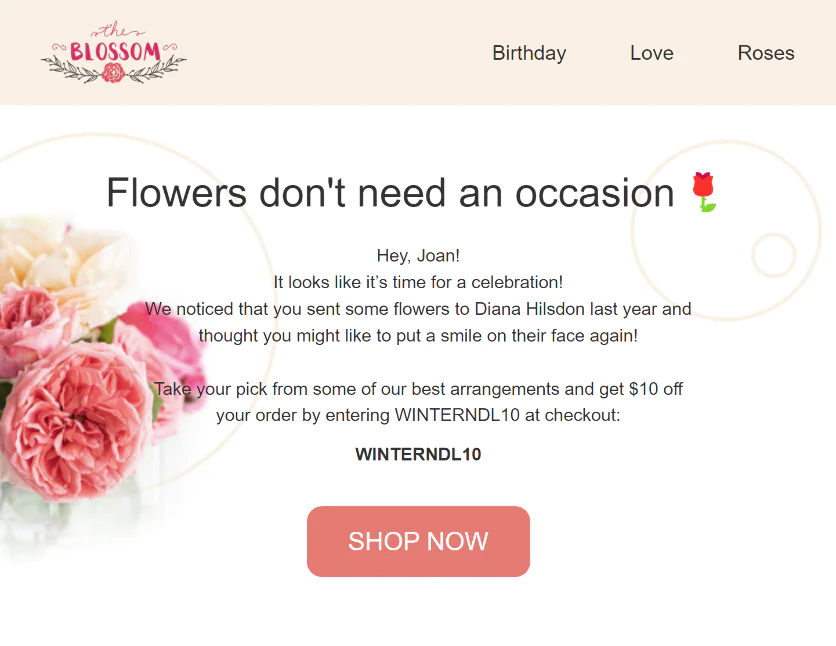
This campaign is sent to customers who ordered flowers for a special occasion a year ago
Abandoned Cart/View/Order Emails
Abandoned cart, view, and order emails form a critical triad in email marketing strategies, addressing various stages of customer engagement and potential drop-off points.
Abandoned Cart emails target customers who have added items to their cart but have not completed the purchase. This mail type serves as a gentle nudge, reminding customers of what they’ve left behind and often include incentives like discounts or free shipping to motivate completion of the purchase.
Abandoned View emails cater to potential customers who have shown interest by browsing through various products or categories without adding anything to their cart. These types of emails aim to rekindle that interest, highlighting the products they viewed or offering recommendations based on their browsing patterns. This strategy helps keep products and categories top-of-mind and can guide customers back to the website to explore further or make a purchase.
Abandoned Order emails address instances where customers begin the checkout process but do not complete the payment. This could be due to various reasons, from technical issues to second thoughts. Emails targeting this group focus on resolving any potential obstacles, offering assistance, or providing gentle reminders to complete the transaction. They can also reassure customers about security measures and return policies to build trust and encourage the completion of the purchase.
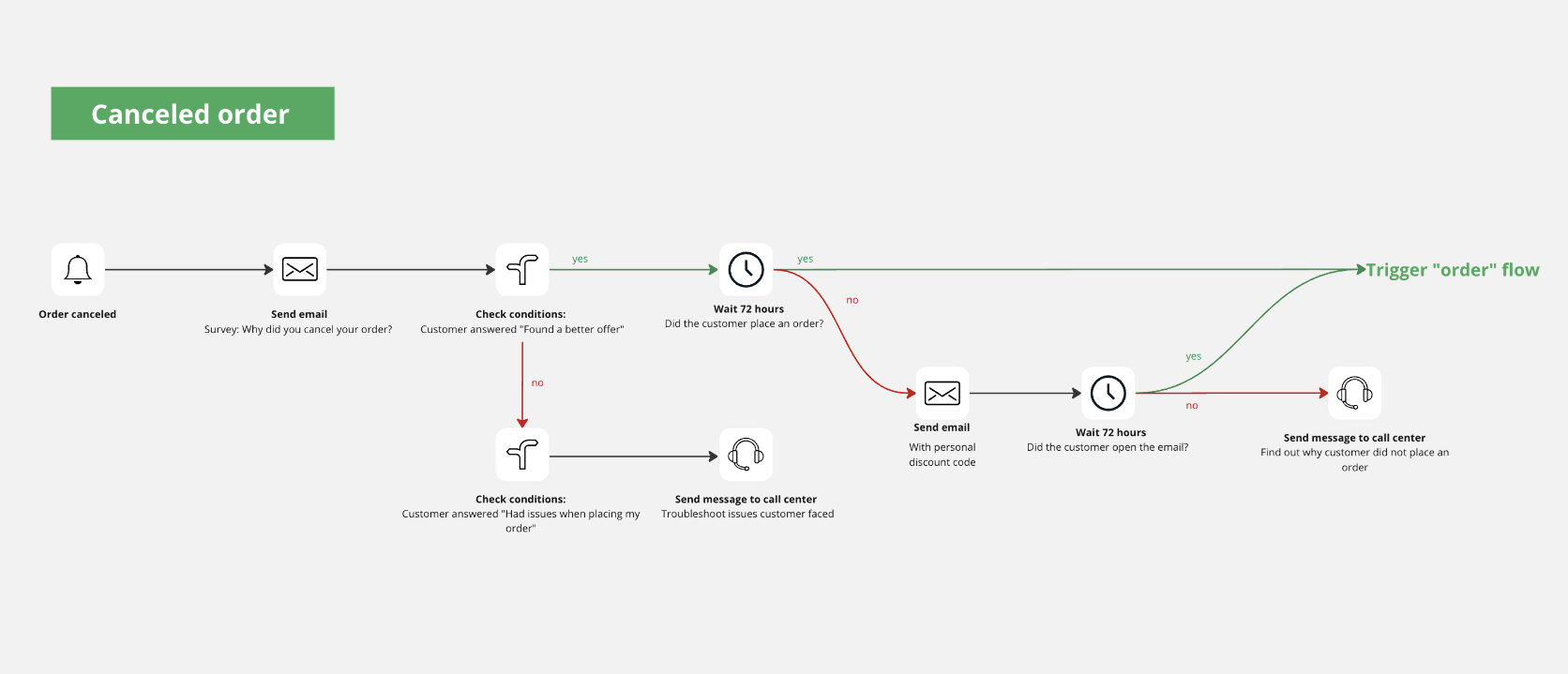
An example of a series of emails addressing an abandoned order
When to Send “Abandoned” Emails
For abandoned cart emails, the first email should ideally be sent within a few hours of abandonment, capitalizing on the customer’s recent interest. A follow-up email can be sent within 24 hours if the first one doesn’t convert, and possibly a third email a few days later, perhaps with an added incentive.
In the case of abandoned browse emails, timing can be a bit more flexible. Waiting a day or two before sending the first email gives the customer some space, while still keeping the products fresh in their mind. A follow-up email can be scheduled a week later to reiterate interest or offer new suggestions based on their browsing behavior.
For abandoned payment emails, immediacy is key. Sending the first email within an hour of abandonment can address any immediate technical issues or concerns the customer might have had. A follow-up email after 24 hours can serve as a reminder and offer additional support or reassurance about the security and reliability of the transaction process.
Jewelry brand German Kabirski, for example, uses automated campaigns in Maestra to send abandoned view and cart emails:

This campaign is sent to customers who browsed items on the website and did not add anything to their cart

This email is part of an abandoned order flow with multiple emails for customers who have added items to their cart without completing the checkout process
Tips on Launching an Effective Email Campaign
Email marketing campaigns can be a powerhouse for engagement and sales if executed with precision and creativity. Here are some essential tips to boost the effectiveness of your email campaigns:
- Start with basic campaigns that immediately generate profit. Initiate your email marketing with fundamental yet profitable strategies such as welcome sequences, abandoned view reminders, abandoned cart notifications, and reactivation emails. These basic tactics often result in immediate gains by addressing key customer behaviors and decision points.
- Collect extensive customer information for personalized campaigns. The more you know about your customers, the more tailored and effective and engaging any type of email campaign can become.
- Analyze and adapt competitors’ successful strategies. Keep an eye on the tactics employed by competitors or businesses with similar models. Don’t hesitate to adapt successful strategies for your campaigns. Remember, what works for one business may not work for another — and that’s perfectly normal. Learning from the market can provide valuable insights for shaping your own campaigns.
- Use discounts and promo codes strategically to preserve margins. Avoid offering discounts and promo codes to all customers as it can erode profit margins. Instead, target segments that are more likely to churn or offer mass discounts sparingly, such as no more than once a month. This approach ensures that offers remain exciting and valued, rather than expected and undervalued.
- Generate hypotheses and test email campaigns on selected audience segments. Continuously generate new ideas and test them on different audience segments to identify the most effective tactics. This iterative approach allows for fine-tuning your strategies based on actual customer responses and behaviors, ensuring that your campaigns are continuously optimized for maximum impact and efficiency.
Final Thoughts
From newsletters that keep your audience engaged, to targeted promotions driving sales, and milestone emails that celebrate and personalize customer experiences, different types of email campaigns each offer a distinct way to connect with and understand your audience. By implementing varied types of campaigns and aligning them with strategic insights, your business can effectively utilize email marketing not just as a tool for direct communication, but as a powerful medium to foster lasting customer relationships, gather valuable insights, and drive sustained business growth. Ultimately, the key lies in knowing your audience, continuously evolving your strategies, and authentically connecting with customers at every possible touchpoint, not just email.
For more campaign ideas, check out our detailed guide with 7 essential automated communication flows for B2C companies.


